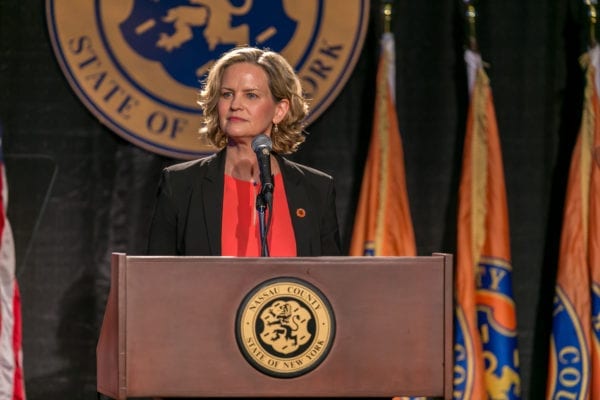Nassau County Executive Laura Curran and Comptroller Jack Schnirman said on Tuesday that they want to reassure residents that participating in the 2020 U.S. census is safe and secure, and stressed the importance of the count now, more than ever, due to the coronavirus.
Curran said in a telephone interview that she has called on the county’s offices of Hispanic, Asian and Minority Affairs and created a committee of local officials and community members to raise awareness about the census.
“A lot of their responsibilities include reaching out to communities, helping people how to fill out forms online or over the phone, telling their friends, and helping spread information on the importance of being counted, especially for this year,” Curran said.
Last year, Curran launched an initiative to spread awareness about the census, headlined by the formation of Nassau’s Complete Count Committee. The committee comprised more than 30 nonprofit, labor and faith-based groups. Schnirman is a co-chair of the committee and spoke on how the comptroller’s office plays a role in creating awareness of the census.
“The census ultimately decides how federal funds are given to us, and the comptroller’s office directly deals with the county’s financial state,” Schnirman said in a separate phone interview. “There is so much money riding on this for Nassau County and all of Long Island. This affects our roads, our health care, our schools, a lot of necessities people may not realize.”
Schnirman noted that New York is a “donor state,” which means it sends more funds to the federal government than it receives in aid. Schnirman cited Curran and her counterpart, Suffolk County Executive Steve Bellone, for their support for making information about the census easily accessible for residents. He also touted the work of North Hempstead Councilwoman Viviana Russell, a co-chair of the committee, for her work.
“[Russell] has been such a phenomenal partner to work with over the past year and a half,” Schnirman said. “The Health and Welfare Council of Long Island has also been extremely supportive and active in their efforts to publicize this information and spread the word about how important this year’s census is.”
Rebecca Sanin, president and CEO of the Health and Welfare Council of Long Island, said concerns about cybersecurity and leaking of information have been raised by residents throughout the island.
“A lot of people are going to be reluctant to complete the census,” Sanin said. “The national anti-immigration sentiment is one of the biggest barriers to an accurate count.”
Curran said she wanted to reassure people that the census data will strictly be used for statistical purposes for federal matters such as funding and congressional representation.
“Not only is this process helping the communities people live in, but it is actually a felony for the Census Bureau to share this information,” Curran said.
According to data from the U.S. Census Bureau, 65.7 percent of Nassau County residents had responded to the census as of May 22, the highest percentage collected from any county in the state. Curran noted the efforts by the county and residents to ensure they are counted in the census.
“Despite the difficulties brought on by [the coronavirus pandemic], we were first in the state in terms of response rate before the door-to-door portion of the counting occurred,” Curran said. “We did find that communities with lower socioeconomic advantages had a lower rate of responses.”
According to census data, more than 316,000 people, or roughly 23 percent of the county’s population, reside in “hard-to-count communities” such as Lakeview, Elmont, Hempstead, Valley Stream, Uniondale and others. The Village of Hempstead, Curran said during a June news conference, had a 47 percent response rate, which could still be improved ahead of the Sept. 30 deadline for self-responses.
The county’s minority population reached 38 percent in 2016, an increase from 30 percent in 2005, according to figures provided by Schnirman. Census data also showed that the county has roughly 112,000 foreign-born nonresidents, roughly 8.3 percent of the population.
“When it comes to the census, the stakes have never been higher for Nassau,” Curran said. “I’m renewing our push to encourage every resident who calls Nassau home to complete the count. This census is about more than just ensuring we finally get our fair share of federal government dollars when we need it most.”
For more information on the census and how to be counted, visit the county’s website at https://www.nassaucountyny.gov/4710/Census-2020.



